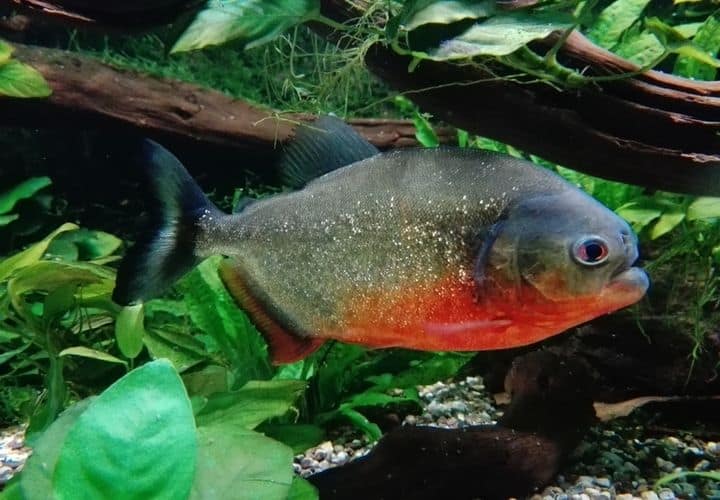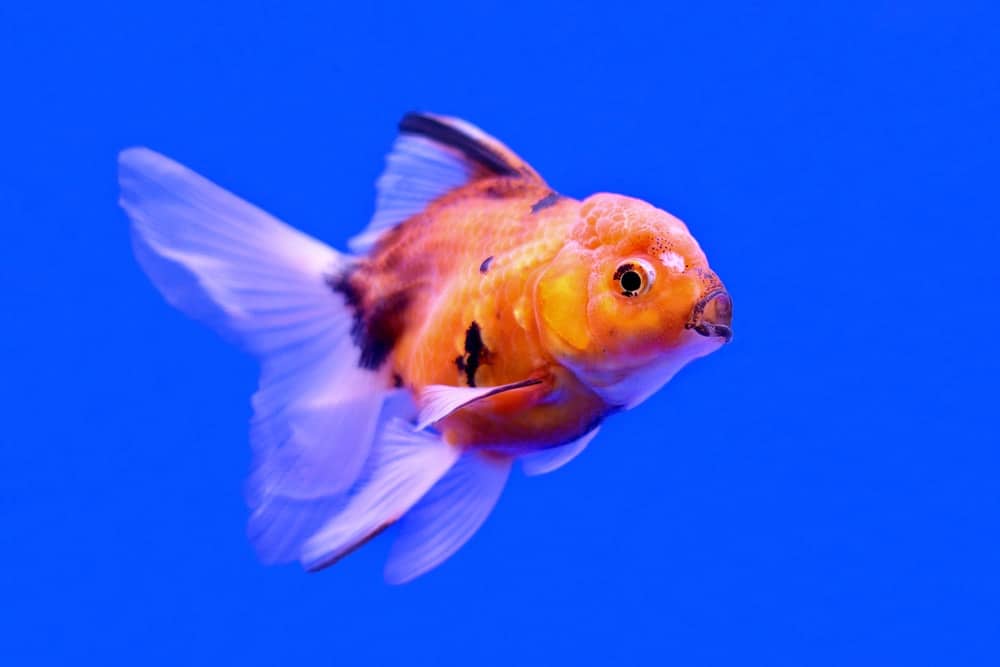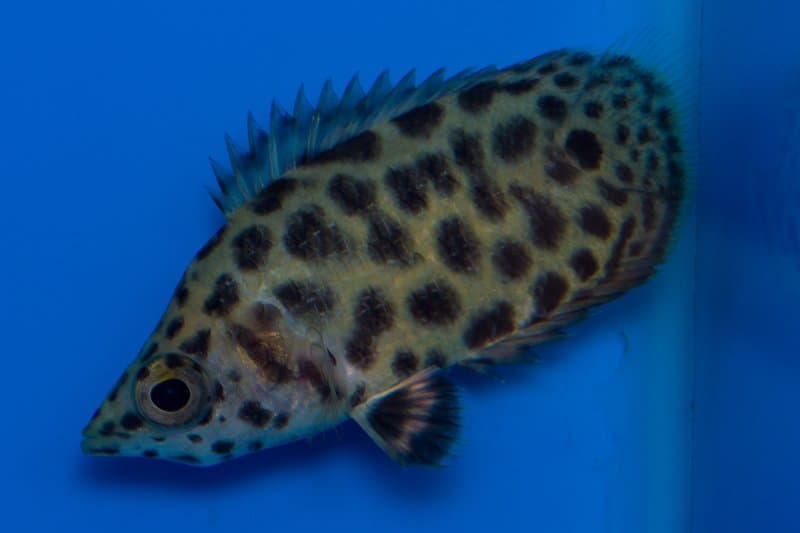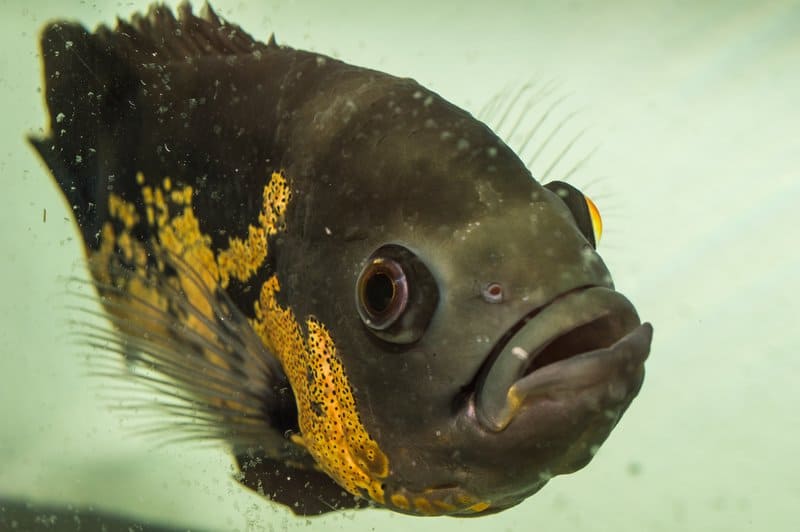Have you ever questioned the aggressive nature of your little swimmer? Does it bother you when your fish bully other fishes in the aquarium? Well, here is a list of some of the most aggressive freshwater fishes out there and how to look after them.
There are millions of freshwater fishes and a good number of them are aggressive. Like with all aggressive animals, a number of precautions must be taken before directly dealing with them. They require special care and when done right they can be relatively harmless to both humans and fish.
Although there are thousands of aggressive freshwater fishes, only a few of them can be actually found in the typical aquarium setup.
Fishes are aggressive for a lot of reasons and they are usually over territory, mate, parental responsibility and sometimes just because they can.
Some fishes, however, can’t be classified as aggressive. This is because in most cases the environment dictates the aggression.
These kinds of fish usually only attack other fishes once in a while and on normal days, they are simply docile. These kinds of fish aren’t quite like the rest, they are known as semi-aggressive.
Here are a few of the more aggressive fish that can be found in certain aquarium setups;
- Convict cichlids
- Tiger Barbs
- Red-bellied piranhas
- Snakeheads
- Freshwater stingrays
- Goldfish
- Angelfish
- Gouramis
- Plecostomus
- Rainbow Shark
- Betta fish
- Neon Tetras
- Leopard Bush Fish
- Oscars
- Green Spotted Puffer
Convict cichlids
These guys are one of the easiest fishes to care for a period. Their name is delightfully amusing and surprisingly not related to just aggressive these little guys can be left unchecked. The male and the female convicts exhibit varying degrees of aggression and once you have figured them out, they are fairly easy to handle.
Convict cichlids are quite the territorial bunch. They do not do well with others and they have been known to pick fights with larger fishes. these guys are best left with their own kind in a tank of about 30-40 gallons.
They hail from the warm streams of central America and they are quite resilient. They don’t require much in terms of care and are basically omnivores. They usually top out in size around 6 inches and they are also known as zebrafish. they prefer water that is stable at around 78 degrees Fahrenheit.
During mating season, they are usually more aggressive. After the eggs hatch, they reduce their territory and aim to kill. They look after the hatchlings and provide food shelter and everything else for the first four days but after the fifth the dynamic changes.
On the fifth day, the fry abandons their yolk case and begin to swim like normal fishes and then the male gets a little bit aggressive towards them. during this phase its always better to remove the male from the tank immediately.
Overall, they are a great choice of fish, they are just incredibly territorial. It would be best to keep them in isolation or with much larger fish.
Tiger Barbs
These guys aren’t the most aggressive of the bunch but they do nip fishes here and there. they move in a school and usually grow up to 3 inches. They prefer water temperatures of around 68-79 degrees Fahrenheit.
A single tiger barb will definitely terrorize smaller fishes and can end up killing it if they are not kept in schools. When kept in schools they usually only fight amongst themselves and scarcely bother other fishes.
School or not, they are still quite the problem and so it would be better if they were paired with larger fish or no fish at all. They are omnivorous and have been known to devour their own young so it would be wise to separate them after the spawning process.
There is no simple reason for their aggression, they just enjoy the violence. They come in different colors and are best left to themselves.
Red-Bellied Piranhas
Despite what the media suggest Red-bellied Piranhas aren’t as deadly to humans as most make it out to be. They are a predatory species that originally originated from the Amazon and have become somewhat coveted pets in more recent times.
They are omnivorous fishes that are best maintained in shoals and don’t quite play well with others. they are mostly mild mannered and are not necessarily always violent and hungry
Snakeheads
They are so-called because of the flat scaled covered head they possess. Unlike most of the fishes on this list, they are carnivores. They have been known to prey on smaller fish and they are mostly docile as far as they are not provoked.
They need oxygen every once in a while, and you should factor that into the equation if you are looking to get these little guys as pets. They are very violent towards smaller fishes and will attack and consume any fish that is smaller than them.
They can be managed by placing them in tanks where they are relatively smaller than the rest of the fishes. Since they are carnivores, most think that they are dangerous and must be kept on a live diet and this is so not true.
You can give them little chunks of meats and they should be relatively fine. They are expensive and they prefer their water that are 68-79 degrees Fahrenheit. The pH should also be in the 6.0-7.0 bracket.
Freshwater Stingrays
There are numerous types of freshwater stingrays out there and there is a rule of thumb that applies to all of them. they are not dangerous as far as they are not provoked. Once provokes, they will attack head-on with their stingers and even though freshwater stingrays are not particularly poisonous, they can be quite harmful and cause immense pain.
They are graceful creatures that you could add to your tank to spruce things up a little bit. Some stingrays grow as large as 30 inches and they play well with others. these guys can be placed in the same tanks with cichlids and some species of severums.
They are relatively easy to take care of but they are very particular about you getting the water right. They thrive in environments that are around 78 degrees Fahrenheit and they prefer soft waters.
They need large tanks of about 75-125 gallons and they generally mate after they have reached sexual maturity. They are omnivores and they love live prey; it would be more advisable to not keep smaller fishes in with them.
They are in the usual habits of borrowing into the aquarium substrate so it would be a nice idea to go with fine sand instead of gravel.
Goldfish
These little guys can be quite aggressive towards newer fish when they fear a shift in the balance of things. Goldfish are one of the most peaceful types of fish that can ever grace your aquarium. They are not difficult to look after and most times they are considered the beginner’s choice.
Goldfish can get testy and tear at other fishes’ fins in some rare instances. They usually get especially aggressive towards weaker and sick fish.
They have been known to frantically chase unsuspecting fish and almost kill them. scientist think that is some form of self-preservation and they only attack the sick fish because they don’t want to get sick but we don’t really think so.
They can also get very aggressive when they feel like there isn’t enough room to go around. In some cases, they fight and try to reduce the population of the tank.
They are also known to bully new neighbors and don’t relent until they are satisfied- which in most cases is never.
The only way to deal with your little macho goldfish is isolating it for the next few days. it would also help to quarantine sick fishes early enough and try to make sure that most fishes in the aquarium share similar sizes, that way there will be fewer territorial disputes.
Angelfish
Angelfishes are aggressive when it comes to feeding. When they are not feeding, they are relatively easy to handle.
Of course, you have to compensate by trying to make sure that the other types of aquarium fishes are not totally left starving, but aside from that they there shouldn’t be an issue.
They are rarely territorial but it is advisable to make sure that there is more than enough room for all the angelfish you wish to keep.
Gourami Fishes
Gourami fishes are one of the most territorial freshwater fishes out there. although there are numerous types of gourami, they do not possess varying degrees of aggression towards others; they are territorial all the same.
They are usually aggressive towards smaller fishes because they feel the need to establish some form of hierarchy and they are also aggressive towards fishes that threaten their established territory.
Gouramis feel the need to establish some form of hierarchy in the tank and the introduction of a larger and much more domineering fish is bound to immediately kill most of the tank aggression instantaneously.
You could also try other methods of controlling them such as dividing the tank and throwing in a lot of tank ornaments such as plants, caves and other little constructions. This will buy the victim fishes more time to escape, it’ll also help them hiding spots.
They hail from southeast Asia and thrive in slow-moving streams and have been known to survive in stagnant waters. They prefer water with the temperature at 75-degree Fahrenheit with a pH of about 7.1. they should be fed with fish flakes and are sometimes aggressive to their own kind.
Plecostomus Fish
Plecostomus fishes aren’t aggressive in the traditional sense, they just take fish cannibalism to a whole new level. They don’t go around attacking other fishes and they are mostly fine keeping to themselves. They are quite like us in the sense that they require a very complex diet.
In some cases, they have their preferences but most common plecos will settle for driftwood, biofilms, algae, and invertebrates. They have been known to eat the dead fishes when they can and the only way to outright prevent this is to keep them on a healthy diet.
They have been known to swallow smaller fishes here and there and they usually prefer waters that have temperatures that range from around 72-76 degrees Fahrenheit. They are nocturnal and they can sometimes live for up to 15 years.
Rainbow Sharks
These omnivorous fishes hail from Thailand and have a typical lifespan of around 4-5 years. They are notorious for being territorial and they are hardly live up to the hype that their name suggests.
They are bottom-dwelling fishes that live off the algae that grow down there and are surprisingly territorial when it comes to maintaining their bottom territories.
Sometimes they go as far as even attacking other rainbow sharks. They thrive in warmer temperatures that range from about 75-81 degrees Fahrenheit and they love water with a pH of around 6.5
Betta Fish
Originally betta fish weren’t particularly aggressive. However, centuries of selective breeding have left them a little bit on edge. Despite the alternative name Siamese fighting fish, they aren’t quite as aggressive, at least not more than the average cichlid.
They have been known to be mildly territorial and they mostly rely on intimidation and not actual violence to maintain their territory.
Neon Tetras
Neon tetras are Amazonian fishes that thrive in more tropical environs and are beloved by all because they are fairly easy to handle. They are instinctively non-aggressive and usually live for up to 8 years.
In rare cases, tetras have been known to just outright bully other tetras. There have been instances of the younger fish bumping against the older ones and there are also instances where they chase them down and attack them. In my experience, the aggression is usually dissolved when females are added to the school.
Leopard Bush Fish
This little fish prefers warmer, more tropical waters and is quite territorial when you think of it. they enjoy idling around all day and sometimes even rarely attack smaller unsuspecting fishes.
They are the type to move towards the top of the tank when its feeding time and they have been known to chase down those who trespass. They come from the Congo River Basin and they love little ornaments in their so-called microhabitats
Oscars
They are similar to other cichlids in that they are very territorial and lay lots of eggs in a relatively short time. They usually grow up to about 18 inches and can weigh up to 3.5 pounds easily.
They are not obsessively territorial. They just tend to protect their newly formed habitat quite aggressively. They hail from Peru and love the water at a toasty 55 degrees Fahrenheit.
Green Spotted Puffer
Green spotted puffers are by far one of the most aggressive types of fishes you can keep as a hobbyist. They will attack and even sometimes kill other pufferfishes in the aquarium.
Home to southeast Asia, this little guy prefers brackish waters and generally fair well in a mixed aquarium. These carnivorous six-inch fishes have to be kept on a constant diet of miniature sea life if they are to stand the chance of living a long life. Like most tropical fish they thrive in waters that are around 78-82 degrees Fahrenheit.
Factors that Affect Fish Aggression
Not all the fish on the list are similar. Some are pure carnivores, and others are simply common aquarium fish that can be aggressive provided some conditions are met. Not all fish have uniform levels of aggression.
Some fish are just naturally more vicious and aggressive than others, while others have to be provoked before they become notably violent.
Some carnivores like Oscars have been known to swallow entire fishes whole just because they can. Not all fishes are as abrasive as the Oscar.
Amongst the more docile fish, there are certain reasons or factors that make fishes more aggressive. Some of these factors include the establishment of territories, the sex of the fish, and overall genetic makeup.
Establishment of territory
When mating season comes swinging, certain fishes become surprisingly territorial. They have a more defined sense of territory and they go as far as biting, bumping and in rare cases, killing.
When fish get territorial its always over four things; Food, shelter, sexual partners and in some cases offspring. When territories are established, they are usually ruled by a single fish or a pair and they are vicious when protecting what is theirs’.
Pressure of mating
There are also other factors that might aggravate fishes considerably. fishes are not humans; they don’t mate for life like some of us do. They tend to go with the fish that are more attractive and leave their former mates.
They prefer mates that have more domineering features and often set their former mates aside. When this happens, the abandoned tend to get significantly more aggressive. I guess all males regardless of their species hate rejection. This behavior is more popular amongst cichlids and snakeheads.
Parenting
When a breeding fish has successfully mated, they tend to reduce their territory and gather around their eggs to protect them from other predatory fish in the aquarium.
Although most fish are not necessarily after the eggs, most fishes are territorial after mating. And they even get more territorial when the eggs hatch.
Light intensity
Not all instances of territorial aggression are caused the breeding, the pressure of mating or intruders, aggression can also be caused by light intensity. Light intensity deals with the amount of light that actually makes it through the water surface into the tank at any given period in time.
It has been noticed that when the light intensity is more concentrated, fishes tend to be more aggressive and although the relationship is not so readily apparent, a more in-depth look has revealed a lot.
With the light intensity low, territorial fish are unlikely to see the full extent of their so-called territory. The low light limits their field of vision and allows the more docile fishes to move around with less fear and restriction.
The sex of the fish
Sex plays a major role in all relationship and when it comes to fishes and the establishment of hierarchy and control. Male and female convict cichlids have been noted to share varying degrees of aggression towards other fishes of their own gender when trying to establish hierarchy and control.
In a tank that the fishes are mostly female, there is a huge power play during the first few days of living in the tank. The larger fish usually fight and dominate the weaker ones when and the smaller ones stand their ground to the best of their abilities.
Female aggressive fishes always end up letting up on the other weaker members of the tank after four days. by then some form of hierarchy has been established and the smaller fish simply submit.
Male fishes, however, are very different from their female counterparts. They tend to remain vicious and aggressive long after the first few days of living the tank.
They don’t stop being aggressive simply because the challenges don’t stop coming. They need to keep fighting if they want to keep the control they have established, so that could explain the constant aggression coming from certain fish in the aquarium.
Genetic makeup
Sometimes certain fishes are just wired to be more aggressive than others even if they are in the same species. It has been noticed that a rare mutation exists in certain fishes that spikes their levels of aggression. These overly aggressive fishes cannot regulate their levels of Histamine.
Histamine is a neurotransmitter that controls a fish’s appetite, sleep, and other important things. certain fishes come born with an imbalance that causes them to produce more histamine than they actually need, this can result in an overall increase in aggression.
Growth hormones can sometimes influence the levels of aggression in certain species. Juvenile fishes have a surprisingly hard time dealing with the sporadic changes that go on in their bodies.
The over secretion of growth hormones leads to an increased synthesis of tissues and as a result, there is a need to consume more food to meet up with the rapid demands of their developing bodies.
The most aggressive freshwater aquarium fish?
The most aggressive freshwater fish that can fit into your aquarium is the red-bellied piranha. These guys will attack anything that moves in the water as far as it is edible. They are disorganized in their movements even though they swim as a collective.
They haphazardly attack any fish animal or man that comes close and they have razor sharp teeth for rending flesh. You usually need a permit to get these guys and they are quite expensive to keep.
Although fish aggression can be largely explained amongst some fishes, there is still a lot that remains a mystery. scientists like to believe that some fishes aren’t just instinctively cruel and terrible fish neighbors and in truth its pure speculation.
Although these aggressive breeds can be managed right if you take all the necessary precautions but I’ll advise against stocking up on the more deadly species even though they are only paired with their kind.
They might be infinitely more exciting than the average betta, but they are simply not worth the trouble if that means that you’ll be putting other fishes in danger.
















